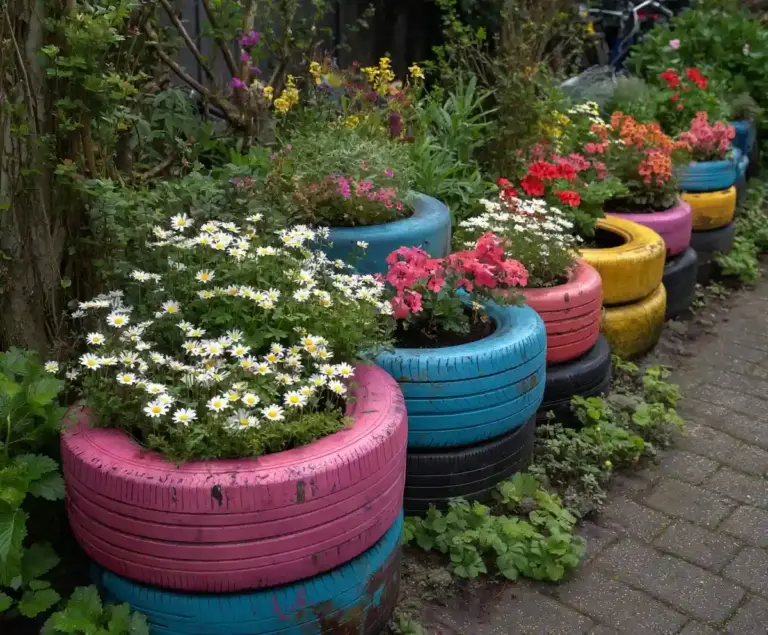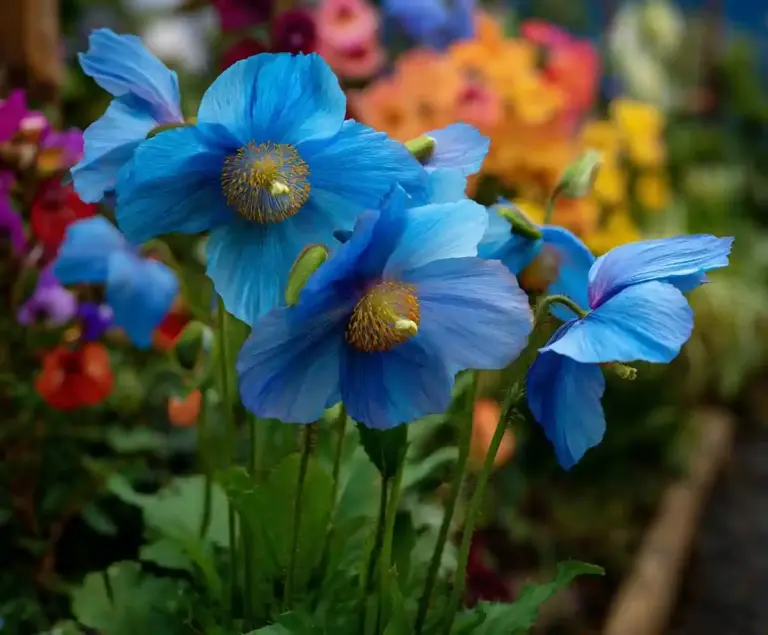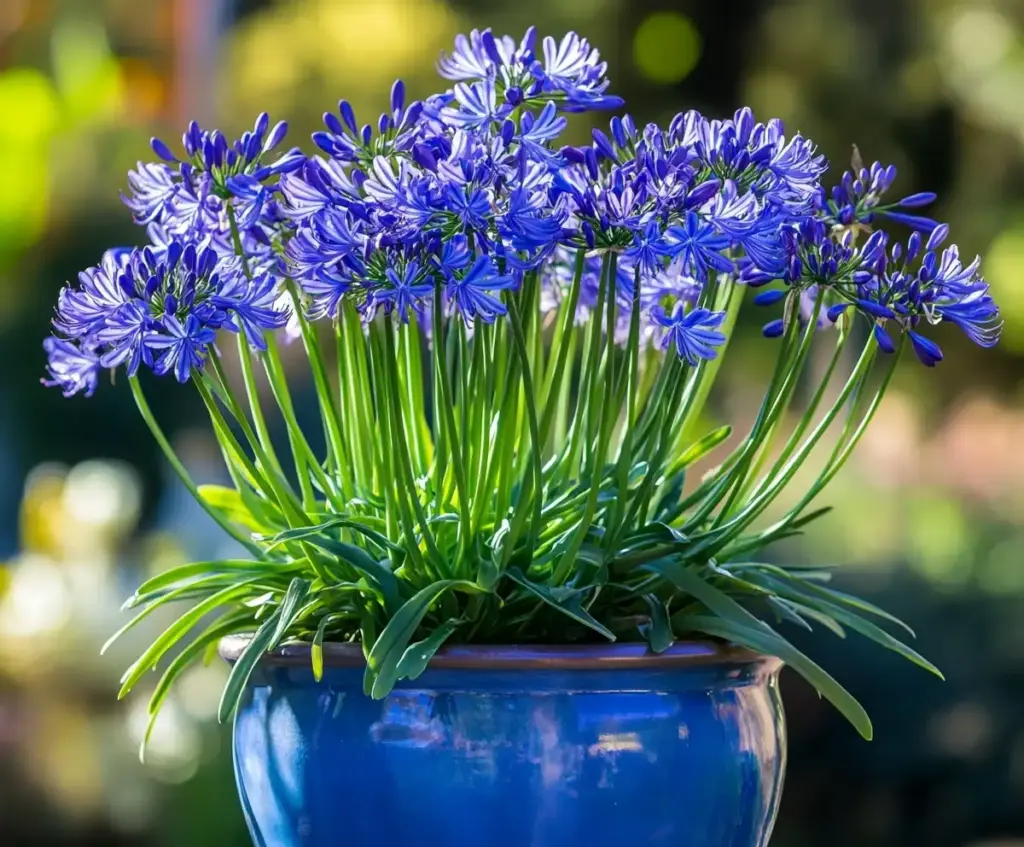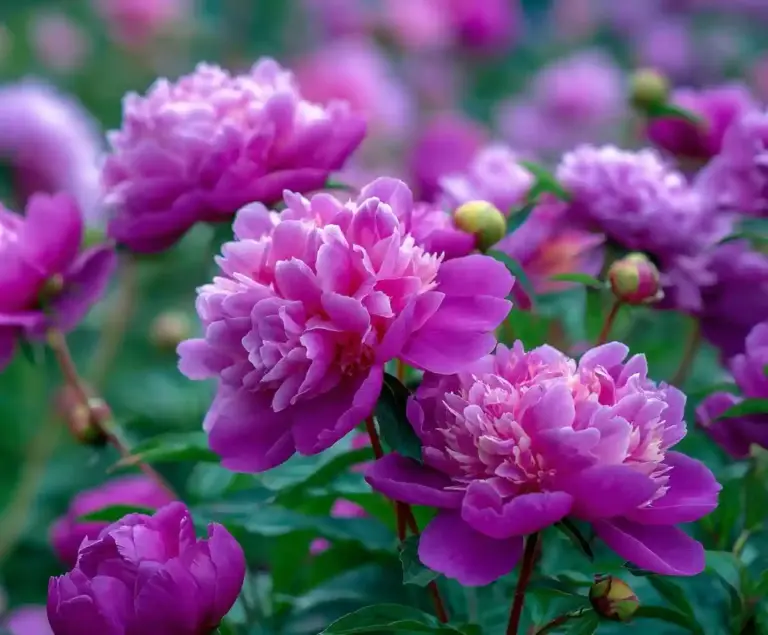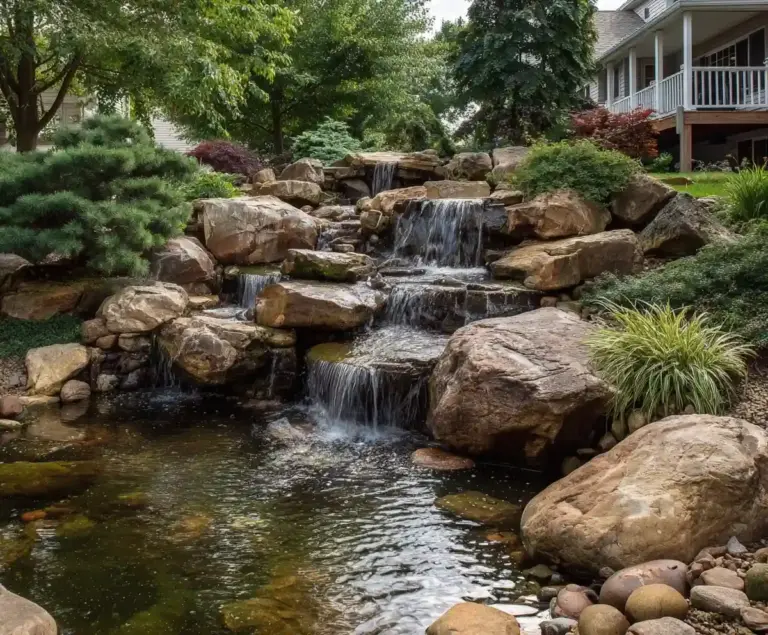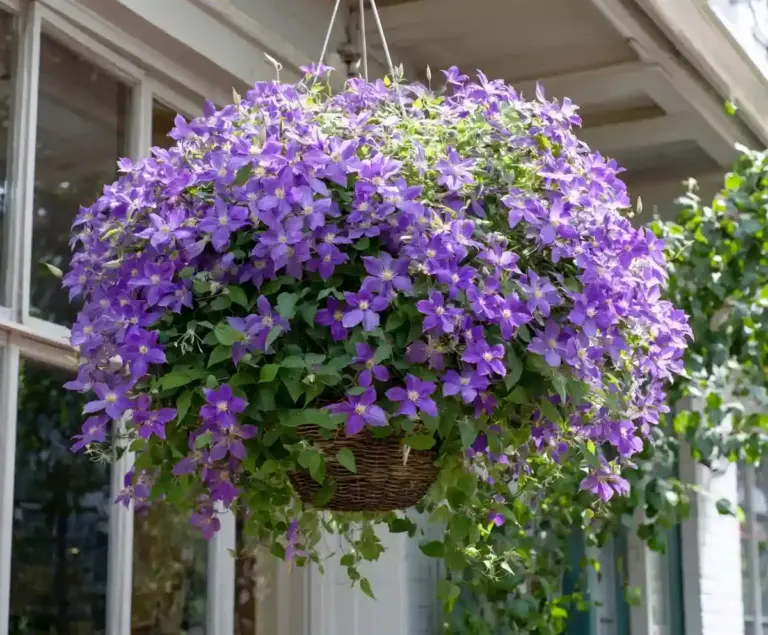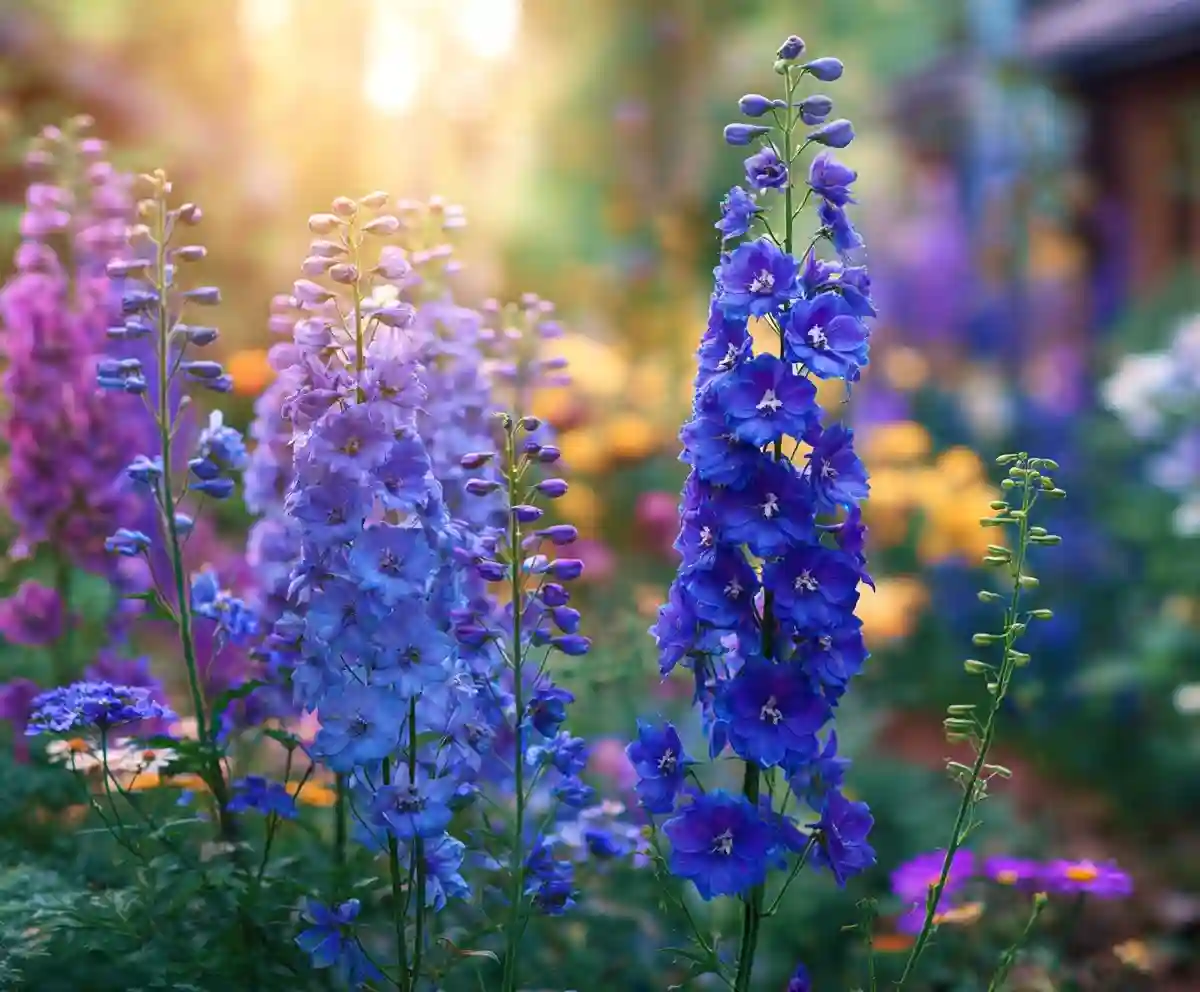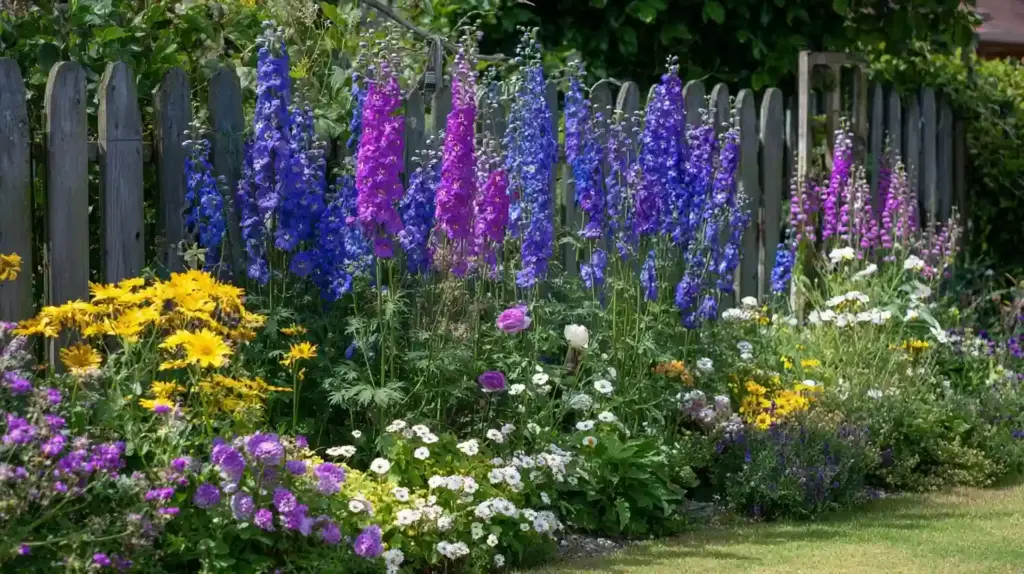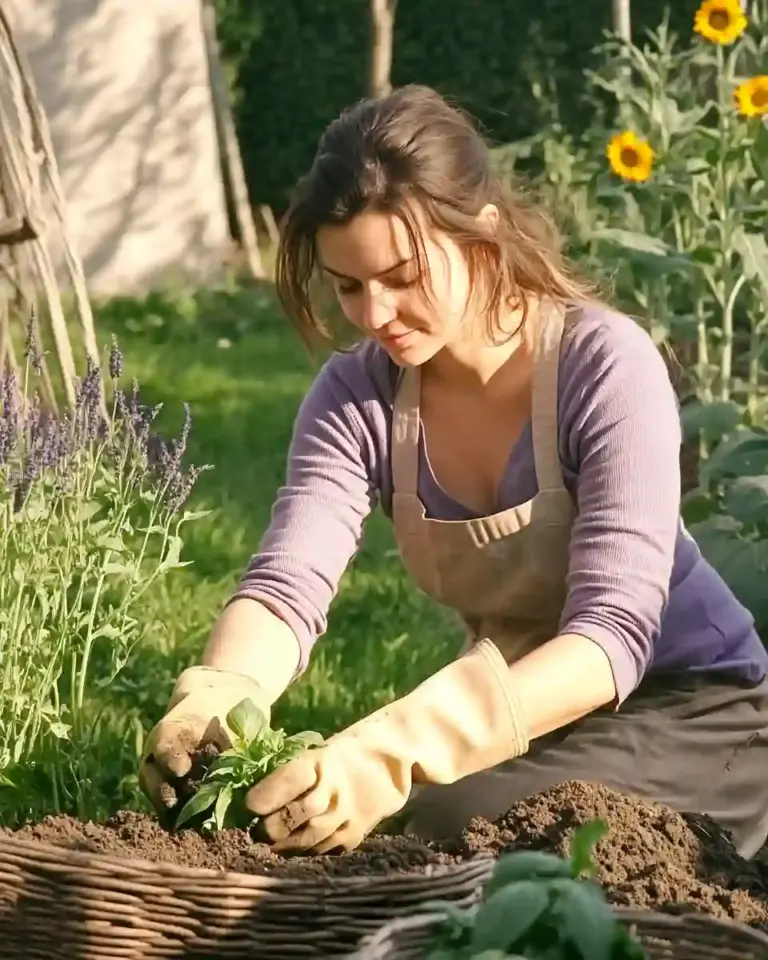Grow delphiniums for a breathtaking garden display that captures attention with towering spires of vibrant color. These elegant perennials, beloved in cottage gardens and classic borders alike, are known for their dramatic vertical presence and irresistible hues—from deep cobalt blues to soft pinks and snowy whites. Whether you’re nurturing a sun-drenched backyard bed or looking to fill a gap in your perennial border, delphiniums reward a little effort with impressive results.
While their beauty might suggest they’re fussy, learning the best way to grow delphiniums in sunny borders is easier than many think. With a few simple strategies—choosing the right location, preparing your soil properly, and offering a bit of seasonal care—you’ll be set for lush blooms that return year after year.
Table of Contents
🌞 Where to Grow Delphiniums
To grow delphiniums successfully, start with the right location—this one decision will make or break your blooming success. These towering flowers crave sunlight and well-prepped soil. Aim for a sunny spot that receives at least 6 hours of direct sunlight daily. Without enough light, stems weaken, and blooms fade prematurely.
Because mature delphiniums can stretch over 6 feet tall, they belong at the back of flower beds where they won’t overshadow smaller plants. They’re also vulnerable to wind damage, so pick a location sheltered by a fence, wall, or dense shrubbery. Protection prevents breakage and helps upright growth without constant re-staking.
If your soil leans heavy—like clay—it’s essential to amend it. Delphiniums detest soggy roots, especially in colder months when excess moisture can lead to rot. Dig in coarse compost or grit to improve drainage. Light, moisture-retentive, well-draining soil with plenty of organic matter is the golden standard.
Quick Site Checklist:
- Sunlight: Full sun (minimum 6 hours daily)
- Soil: Fertile, moist, but not waterlogged
- Wind: Sheltered area to protect tall spikes
- Ideal Placement: Back of perennial borders
- Drainage Tip: Add grit or compost to prevent winter root rot
🌿 How to Plant Delphiniums
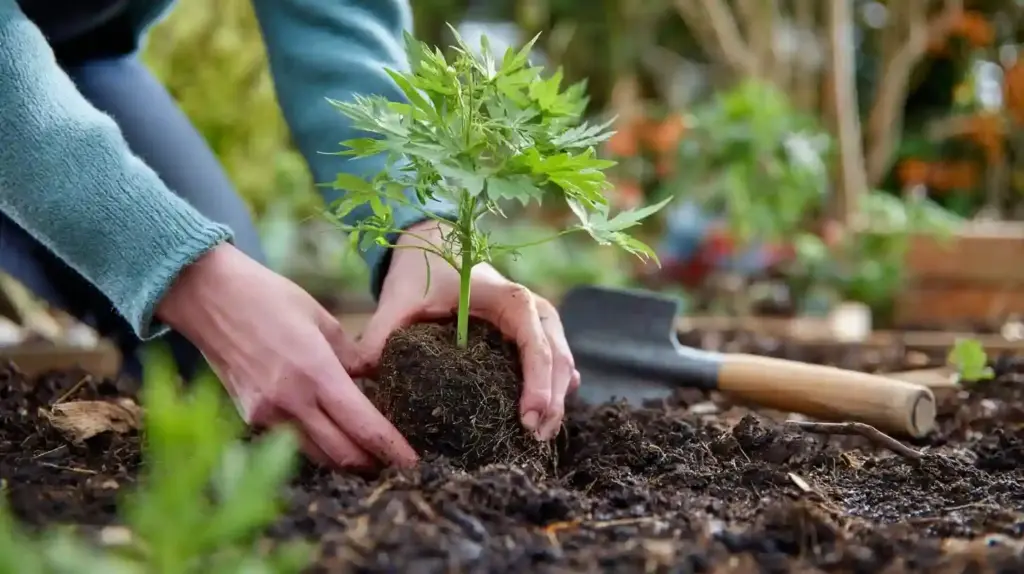
Once you’ve found the perfect sunny, sheltered location, it’s time to plant. You can grow delphiniums in either spring or early autumn—both seasons offer mild temperatures and naturally moist soil, which help young roots settle in without stress. Avoid planting in extreme heat or when the ground is waterlogged.
Step-by-Step Guide to Planting Delphiniums:
- Prepare the Site
- Dig a hole twice as wide as the root ball and just as deep.
- Mix in well-rotted compost or aged manure to enrich the soil.
- If your soil tends to stay wet, add grit or horticultural sand to improve drainage.
- Planting Depth
- Set your delphinium at the same depth it was growing in its nursery pot.
- Avoid planting too deep—this can lead to crown rot.
- Spacing
- Leave about 60–75 cm (2–2.5 feet) between plants. Proper spacing encourages airflow, which helps prevent fungal diseases.
- Water In
- After planting, water deeply to settle the soil and eliminate air pockets.
- Mulch and Protect
- Add a layer of organic mulch (like compost or leaf mould) around the base to retain moisture, suppress weeds, and stabilize temperature.
Bonus Tip:
If you’re planting multiple delphiniums in one area, consider placing taller varieties toward the back and more compact types like Magic Fountain up front for a layered, natural look.
🌸 Caring for Delphiniums
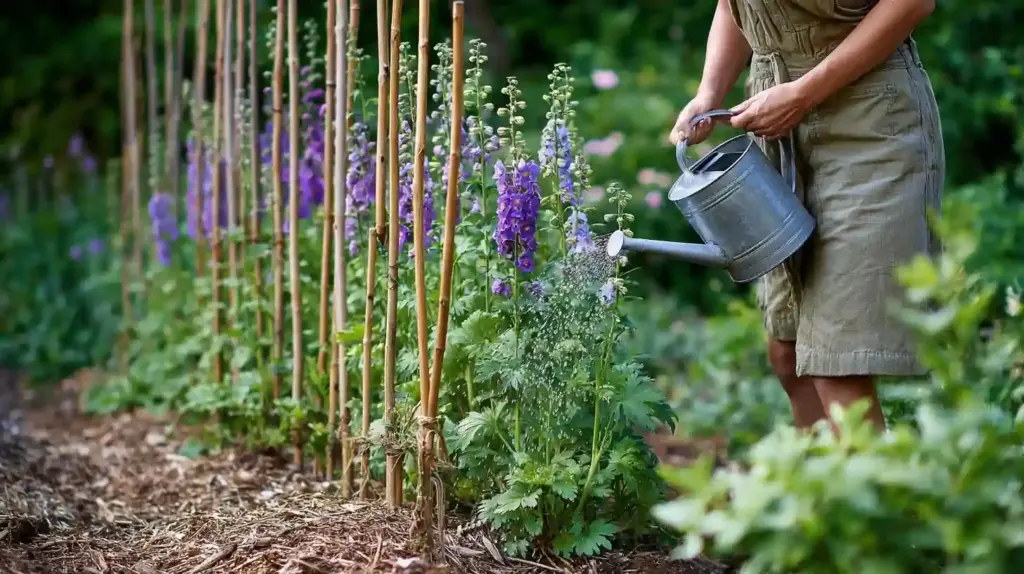
Once planted, delphiniums thrive with a consistent care routine. While they’re not the lowest-maintenance perennial, the payoff—sky-high blooms and lush foliage—is more than worth the effort. To truly grow delphiniums to their full potential, focus on feeding, watering, and structural support throughout the growing season.
💧 Watering Wisely
Delphiniums prefer evenly moist, cool soil, especially during dry spells. They dislike drying out but hate soggy roots even more.
- Water deeply once or twice per week, depending on rainfall.
- Always water at the base to prevent fungal problems on leaves.
- Add mulch each spring to conserve moisture and keep roots cool.
🌿 Feeding for Flower Power
These are hungry plants that benefit from a regular feeding schedule:
- Apply a high-potash liquid feed (like tomato fertilizer) every two weeks starting in early spring.
- Continue feeding until after the first flowering to encourage strong stems and large blooms.
🪴 Staking for Support
With stems reaching heights of 5 to 6 feet, staking is essential—even for sturdier hybrids.
- Begin staking early, before plants flop.
- Use bamboo canes or a grow-through ring support.
- Tie loosely with twine and adjust as the plant grows.
✂️ Deadheading for Repeat Blooms
Want a second flush of flowers? Here’s how:
- Cut back spent spikes to the base after the first bloom fades in early summer.
- Leave smaller side shoots to grow.
- Feed and water again.
- You may see a second wave of blooms in late summer or early fall.
🍂 Seasonal Cleanup
In late autumn, once foliage dies back:
- Cut delphiniums down to ground level.
- Mulch the crown to protect against frost and retain soil structure.
🌱 How to Propagate Delphiniums
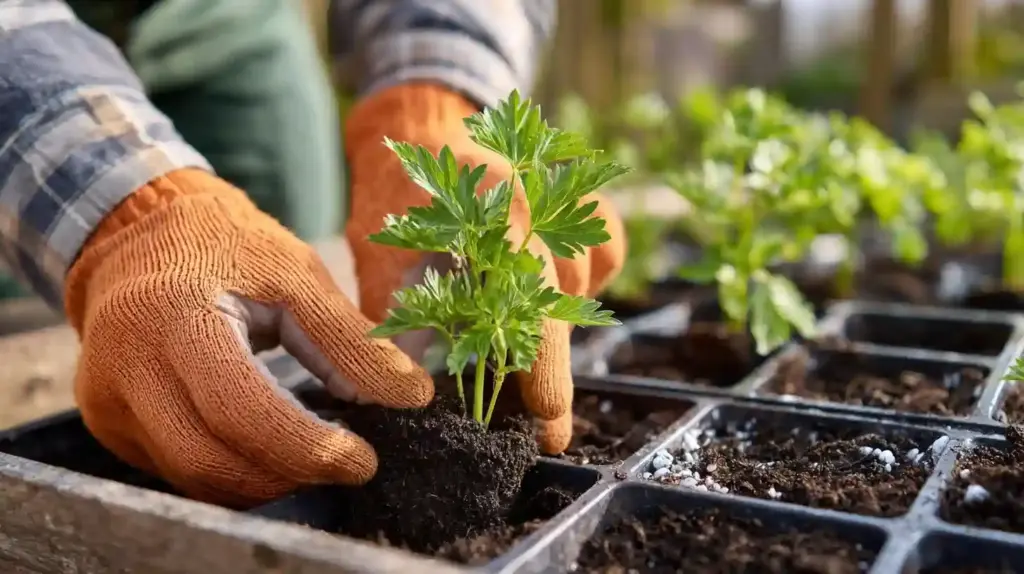
Propagating is a great way to multiply your plants and maintain vigorous growth year after year. If you want to grow delphiniums without buying new ones every season, propagation from seed or basal cuttings are your two best options.
🌾 Growing from Seed
Delphinium seeds are cost-effective but can be a little tricky to germinate. They’re sensitive to age and temperature, so timing and freshness are key.
- Best sowing time: Late winter to early summer (February to June) or early autumn (September to October).
- How to sow:
- Use seed trays filled with moist seed-starting compost.
- Keep trays in a cool, bright place around 50–60°F (10–15°C).
- Lightly cover with vermiculite or fine compost.
- Pro tip: Use fresh seed from a reputable supplier or collect it yourself when flower spikes fade.
Germination may take 2–4 weeks. Once seedlings are big enough to handle, pot them individually and harden off before planting out.
✂️ Taking Basal Cuttings (Best Method)
For strong, identical clones of your favorite plants, basal cuttings are a gardener’s best friend.
- Wait for spring shoots
- Look for fresh, healthy shoots at the base of mature plants—typically in March or April.
- Take the cutting
- With a clean knife, cut just below the soil line, taking 1–2 shoots per plant.
- Prepare the cutting
- Remove lower leaves, leaving a few at the top.
- Place in a moist paper towel or plastic bag if not potting immediately.
- Pot it up
- Use a mix of compost and perlite in a small pot for drainage.
- Insert the cutting and cover with a plastic bag or propagator lid to maintain humidity.
- Aftercare
- Keep in bright, indirect light.
- Mist lightly and wait for roots to form—usually within 3–4 weeks.
Once rooted, move to a larger pot or transplant into the garden when conditions are mild.
🐌 Common Problems and How to Solve Them
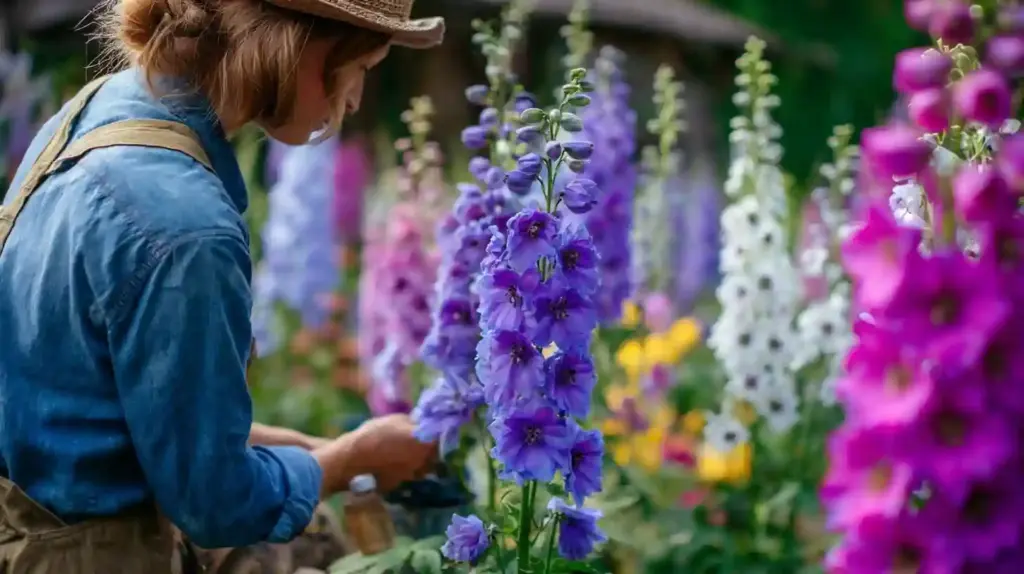
Even when grown in ideal conditions, delphiniums can fall victim to a few common pests and diseases. To successfully grow delphiniums that are tall, healthy, and vibrant, you’ll need to stay one step ahead of the threats—especially in spring and late summer when growth is most vigorous.
🐌 Slugs and Snails
Biggest threat: Young delphinium shoots in early spring are a slug’s dream meal.
What to do:
- Surround plants with crushed eggshells or sharp grit.
- Use organic slug pellets or homemade garlic spray (1 crushed bulb to 1 liter of water).
- Set beer traps or apply nematodes if your soil is moist enough for them to work.
🌫️ Powdery Mildew
This fungal disease looks like a fine white powder on leaves and stems—most common in dry, crowded conditions.
Prevention tips:
- Water at the base, not on the leaves.
- Maintain proper spacing for airflow.
- Apply an organic fungicide if needed.
🍂 Rust
Rust appears as orange or brown pustules on leaves, especially in warm, damp conditions.
How to manage it:
- Remove and dispose of affected leaves (never compost them).
- Rake and clean up all fallen foliage in autumn.
- Use sulfur-based sprays as a preventative.
🦠 Black Blotch (Bacterial Infection)
A serious issue that causes black or brown blotches on foliage—there’s unfortunately no cure.
What to do:
- Remove the entire plant immediately.
- Disinfect tools before using them elsewhere.
- Avoid replanting delphiniums in the same spot for at least a year.
🛒 Buying Advice: Choosing the Right Delphiniums
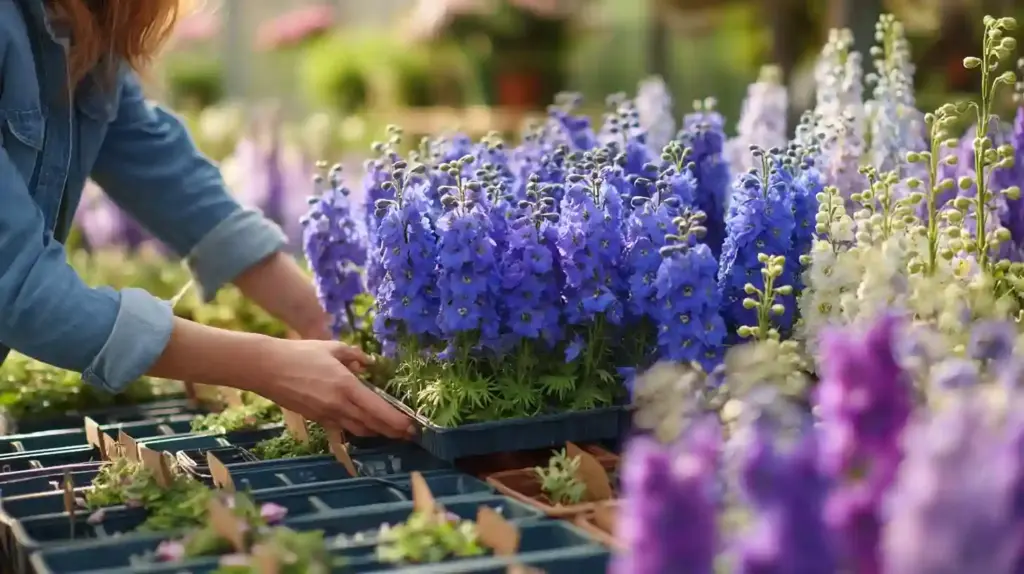
When you’re ready to grow delphiniums, picking the right variety is just as important as planting them properly. Delphiniums come in a wide range of heights, colors, and growth habits, so matching the right type to your garden conditions will set you up for success from day one.
📏 Choose the Right Size
Not all delphiniums are giants—some are bred specifically for smaller spaces.
- Compact gardens or containers: Go for dwarf series like Magic Fountain (under 1m tall).
- Large borders or dramatic backdrops: Choose tall varieties like Elatum Hybrids (up to 2.5m).
🌞 Match Your Conditions
Delphiniums do best in full sun and fertile, well-drained soil.
Before buying, ask yourself:
- Does the planting area get 6+ hours of sunlight?
- Is the site sheltered from wind?
- Can you improve drainage if needed?
If the answer is yes, you’re ready to choose your plants.
🌱 What to Look for When Shopping
Whether you’re at a nursery or browsing online:
- Choose plants with healthy, green foliage—no yellowing or spots.
- Avoid overly tall, leggy plants (they may have been stressed).
- Check for firm, moist roots, not dry or soggy.
💸 How to Buy
- Plug plants (early spring): Affordable and easy to grow on.
- Potted plants: Great for instant color and stronger first-season performance.
- Seeds: Cheaper but more challenging to grow.
- Basal cuttings (DIY): Best for identical, robust plants.
🛍 Trusted Online Retailers (UK examples)
- Thompson & Morgan
- Crocus
- Suttons
- Blackmore & Langdon
- Primrose
- Van Meuwen
🌈 Top Delphinium Varieties to Grow
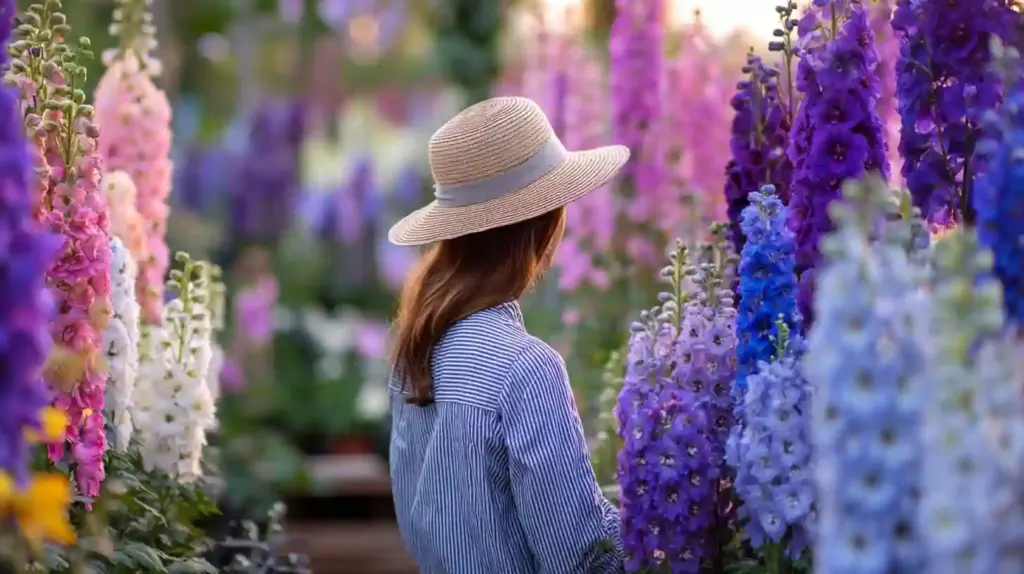
With their impressive range of colors, sizes, and flower forms, delphiniums offer something for every gardener. Whether you’re designing a traditional cottage garden or adding structure to a modern bed, choosing the right variety will help you grow delphiniums that truly stand out.
Here are some of the best delphinium cultivars for different garden styles and needs:
💙 Delphinium ‘Amadeus’
A striking hybrid with rich, velvety purple-blue double flowers and a dark central “bee.”
- Height: ~1.5m
- Spread: ~1m
- Best for: Mid-border drama and cutting gardens
🌸 Delphinium ‘Magic Fountain Series’
A compact series ideal for smaller gardens or containers. Offers a broad color palette including blues, pinks, and whites—all with eye-catching contrasting centers.
- Height: ~90cm
- Spread: ~60cm
- Best for: Pots and front-of-border planting
🌼 Delphinium ‘Pacific Hybrids’
Classic favorites from the 1950s known for tall, stately flower spikes and vivid colors. They’re short-lived perennials but pack a visual punch.
- Height: ~1.5m
- Spread: ~75cm
- Best for: Cottage gardens and floral borders
💫 Delphinium ‘Rising Stars Mixed’
An informal mix of pinks, purples, and blues in single and double forms—perfect for gardeners who love variety and a looser, natural style.
- Height: ~1.5m
- Spread: ~75cm
- Best for: Colorful, free-form beds
🩵 Delphinium elatum ‘Faust’
A dramatic, tall cultivar with deep cobalt-blue double flowers and a black bee. It makes a bold statement in the back of a border.
- Height: Up to 2.5m
- Spread: ~1m
- Best for: Background structure and bold focal points
🌷 Delphinium elatum ‘Cinderella’
Elegant soft-pink blooms on sturdy stems with frilly, triple-layered petals. Winner of the Best New Plant at BBC Gardeners’ World Live.
- Height: ~1.2m
- Spread: ~80cm
- Best for: Romantic or pastel-themed gardens
🌿 Conclusion
To grow delphiniums successfully is to embrace both beauty and a bit of gardening dedication. While they need sunlight, support, and consistent care, the reward is nothing short of spectacular. Whether you favor the towering spikes of Elatum hybrids or the neat blooms of the Magic Fountain series, these perennials offer unmatched elegance in any sunny border.
With proper planting, seasonal feeding, and pest protection, delphiniums will not only bloom in their first summer—but can also come back stronger each year, sometimes even offering a second flush of flowers in late summer. Add in the ability to propagate your favorites and choose from an ever-growing list of varieties, and it’s clear: delphiniums deserve a place in every garden.
🌿 Love gardening inspiration? Follow me on Pinterest for bold plant ideas, tips, and seasonal color!
More Posts
